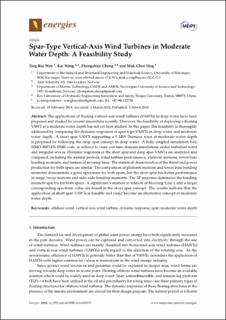| dc.contributor.author | Wen, Ting-Rui | |
| dc.contributor.author | Wang, Kai | |
| dc.contributor.author | Cheng, Zhengshun | |
| dc.contributor.author | Ong, Muk Chen | |
| dc.date.accessioned | 2022-12-15T13:05:48Z | |
| dc.date.available | 2022-12-15T13:05:48Z | |
| dc.date.created | 2018-11-15T18:54:29Z | |
| dc.date.issued | 2018 | |
| dc.identifier.citation | Wen, T. R., Wang, K., Cheng, Z., & Ong, M. C. (2018). Spar-type vertical-Axis wind turbines in moderate water depth: a feasibility study. Energies, 11(3), 555. | en_US |
| dc.identifier.issn | 1996-1073 | |
| dc.identifier.uri | https://hdl.handle.net/11250/3038030 | |
| dc.description.abstract | The applications of floating vertical-axis wind turbines (VAWTs) in deep water have been proposed and studied by several researchers recently. However, the feasibility of deploying a floating VAWT at a moderate water depth has not yet been studied. In this paper, this feasibility is thoroughly addressed by comparing the dynamic responses of spar-type VAWTs in deep water and moderate water depth. A short spar VAWT supporting a 5 MW Darrieus rotor at moderate water depth is proposed by following the deep spar concept in deep water. A fully coupled simulation tool, SIMO-RIFLEX-DMS code, is utilized to carry out time domain simulations under turbulent wind and irregular waves. Dynamic responses of the short spar and deep spar VAWTs are analyzed and compared, including the natural periods, wind turbine performance, platform motions, tower base bending moments, and tension of mooring lines. The statistical characteristics of the thrust and power production for both spars are similar. The comparison of platform motions and tower base bending moments demonstrate a good agreement for both spars, but the short spar has better performance in surge/sway motions and side–side bending moments. The 2P response dominates the bending moment spectra for both spars. A significant variation in tension of Mooring Line 1 and a larger corresponding spectrum value are found in the short spar concept. The results indicate that the application of short spar VAWTs is feasible and could become an alternative concept at moderate water depth. | en_US |
| dc.language.iso | eng | en_US |
| dc.publisher | MDPI | en_US |
| dc.rights | Navngivelse 4.0 Internasjonal | * |
| dc.rights.uri | http://creativecommons.org/licenses/by/4.0/deed.no | * |
| dc.title | Spar-type vertical-axis wind turbines in moderate water depth: A feasibility study | en_US |
| dc.type | Peer reviewed | en_US |
| dc.type | Journal article | en_US |
| dc.description.version | publishedVersion | en_US |
| dc.rights.holder | The authors | en_US |
| dc.subject.nsi | VDP::Teknologi: 500 | en_US |
| dc.source.pagenumber | 1-17 | en_US |
| dc.source.volume | 11 | en_US |
| dc.source.journal | Energies | en_US |
| dc.source.issue | 3 | en_US |
| dc.identifier.doi | 10.3390/en11030555 | |
| dc.identifier.cristin | 1631163 | |
| dc.source.articlenumber | 555 | en_US |
| cristin.unitcode | 217,8,5,0 | |
| cristin.unitname | Institutt for maskin, bygg og materialteknologi | |
| cristin.ispublished | true | |
| cristin.fulltext | original | |
| cristin.qualitycode | 1 | |

